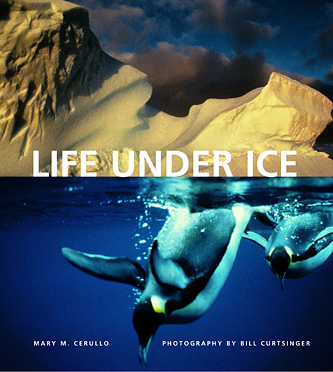
Life Under Ice
Author Mary M. Cerullo Illustrated by Bill Curtsinger ISBN 9780884482468 Binding Trade Cloth Publisher Tilbury House Publishers Publication Date August 06, 2003 Size 229 x 254 mmMarine photographer Bill Curtsinger has returned to Antarctica a number of times to photograph the animals and plants that survive in the icy, ice-capped waters at the end of the earth. Mary Cerullo shares his story with us, telling what it's like to start a diving trip by cutting a hole in ice eight to ten feet thick, then diving into the chilly depths with the light shining through your entry hole the only beacon to your escape route.
Bill's amazing photographs and his and Mary's lively curiosity about the world combine to show us a strange and wonderful part of our earth, where some fish survive by having clear blood that acts like antifreeze, jellyfish and sponges and sea spiders grow enormous, the food chain is short, and even minor changes in conditions can affect the survival rate of baby penguins. We learn how penguins and seals are adapted for life on the ice and under it, how the ice acts like a greenhouse roof for marine plants during Antarctica's summer months, and how it keeps the water warmer than the air during the frigid winter.
Mary Cerullo is an award-winning children's science writer and the author of our two Sea Soup books on phytoplankton and zooplankton, as well as many other children's books, including The Ocean Detectives and The Truth About Great White Sharks. She is the director of Maine's marine environmental organization Friends of Casco Bay.
Like many explorers before him, Bill Curtsinger first traveled to Antarctica as a young sailor. He was in the Navy Combat Camera Group, assigned to photograph the work of National Science Foundation researchers. In the years since, Bill's work has appeared in numerous books (including our Sea Soup books) and in every major world magazine, including thirty-three articles in National Geographic. He lives in Yarmouth, Maine. For more about Bill: www.billcurtsingerphoto.com
Students who wonder what it means to be an "explorer" in today's world will be fascinated by Life Under Ice. This unusual book, filled with dazzling photographs taken above and below the antarctic ice, will help children visualize the answers to their How, What, Where, When, and Why questions about the coldest, driest, and windiest of all places on earth. Life Under Ice depicts National Geographic photographer Bill Curtsinger photographing the plants and animals that survive in and under the icy, ice-capped waters of Antarctica. As part of his job as a photographer, Bill works with many scientists who have traveled to Antarctica to learn about marine life, weather, stars, climate change, and human impacts. This book shows young readers "inquiry based" science up close, and often under ice.
The Antarctica that students will discover is a strange and amazing part of our earth, where some fish survive by having clear blood that acts like antifreeze, jellyfish and sponges and sea spiders grow enormous, the food chain is short, and even minor changes in conditions can affect the survival rate of baby penguins. Readers will also learn how penguins and seals are adapted for life on the ice or below it, how the ice acts as a greenhouse roof for marine plants during the antarctic summer months, and how it keeps the water warmer than the air during the frigid winter. As "the last wild place," Antarctica has held sway over the imaginations generations of children. This book will help young readers understand why we need to protect Antarctica for the future.
Life Under Ice will help inspire classroom conversations about:
Biodiversity, the amazing variety of arctic animals, and their ability to adapt to their environment;
Comparative ecosystems—Antarctica as a "lab environment";
Global warming, ozone, and ultraviolet radiation;
Underwater diving skills and technology;
Scientific inquiry;
Underwater photography;
Research teams;
Ice in the antarctic environment;
Penguins and other antarctic species and their adaptation to extreme cold;
Phytoplankton and the food web of Antarctica; and
Tourism and "eco-tourism."
Additional Books
Danger-Icebergs! by Roma Gans (Crowell 1988).
Explains what icebergs mean to sailors who navigate through arctic waters, around icebergs. (There are icebergs in Antarctica too.)
Icebergs and Glaciers by Seymour Simon (Morrow 1999).
Describes how icebergs are formed.
Activities
Activities are adapted from Mary Cerullo's Reading the Environment (Heineman 1997).
Activity: Exploring Ice Forms — 98 Percent of Antarctica Is Ice!
Let students examine and compare what ice cubes, chunks of ice, and chunks of snow do when placed in a tub of water.
How much of the forms go below the waterline? Use a ruler.
Why does the ice float?
This activity allows children to observe the different properties of water and ice so they can develop their understanding of the unique nature of polar environments.
Activity — Freezing Sea Water: What Happens to the Salt in the Sea Water?
We all know that water freezes at 0°C or 32°F, but is that always true?
Fill four small containers (empty yogurts work well) with equal amounts of water.
Add salt in differing amounts to each container.
Take predictions from kids about which container will freeze first. The one with no salt, a little, or a lot?
This activity helps explain why the ocean around Antarctica isn't always frozen and why the ocean is able to support so much sea life despite the intense cold.